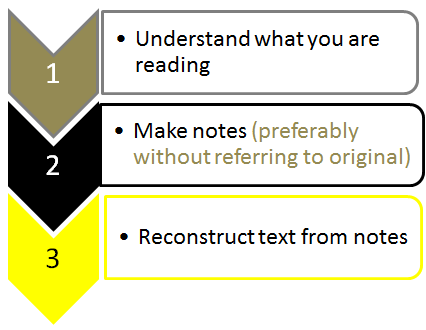Combining strategies (2)
![]() Remember the three basic steps to writing an acceptable paraphrase:
Remember the three basic steps to writing an acceptable paraphrase: 
![]() Employ effective reading strategies.
Employ effective reading strategies.
![]() Think about new vocabulary (synonyms, word definitions).
Think about new vocabulary (synonyms, word definitions).
![]() Combine sentences; construct new sentences to create variety and interest; use a range of paraphrasing techniques.
Combine sentences; construct new sentences to create variety and interest; use a range of paraphrasing techniques.
![]() Guided practice
Guided practice
Text 1: Global warming
 One of the biggest problems facing humankind in the next few decades is the problem of global warming. In the past 150 years, global temperatures have risen approximately 1°C (1.8°F). The year 1998 was the warmest year that had ever been recorded. If temperatures continue to rise, the consequences could be catastrophic. As Earth's temperature rises, polar ice will melt, causing the water level of the oceans to rise. Rising oceans levels, in turn, will cause flooding along the coasts. Global warming will also cause major changes in climate that will affect agriculture. For example, crops that were previously grown in Guatemala may not do so well because it will become too hot.
One of the biggest problems facing humankind in the next few decades is the problem of global warming. In the past 150 years, global temperatures have risen approximately 1°C (1.8°F). The year 1998 was the warmest year that had ever been recorded. If temperatures continue to rise, the consequences could be catastrophic. As Earth's temperature rises, polar ice will melt, causing the water level of the oceans to rise. Rising oceans levels, in turn, will cause flooding along the coasts. Global warming will also cause major changes in climate that will affect agriculture. For example, crops that were previously grown in Guatemala may not do so well because it will become too hot.
Text source: Oshima, A. & Hogue, A (2006). Writing academic English. 4th ed. NY: Pearson Longman, p.263.
Step 1: Read the text and make sure you understand the key ideas in it. Step 2: Make notes. Main idea: rising temperatures and impact on environment, climate and crop production evidence: 1 degree rise in 15 decades; global warming - a real threat to human civilisation Effects: disastrous if trend persists: a) melting ice in Poles-->sea level rises-->widespread coastal flooding; b) hotter weather patterns--> crop failure in regions which have previously thrived and enjoyed better yields, e.g. Guatemala Step 3: Reconstruct the text from the notes. |
Oshima and Hogue (2006) see global warming is a real threat to human civilisation as there is evidence that global temperatures are rising. In fact, it has been recorded that over the past 15 decades, temperatures have increased by 1 degree Celcius. Both argue that if this trend persists, there could be disastrous effects on the environment, climate and agricultural output. Sea levels will rise dramatically from the melting of ice in the Poles, leading to widespread coastal flooding. In addition, hotter weather patterns may also bring about crop failure in regions such as Guatemalawhich have previously enjoyed better yields (p.263).
![]() This is an acceptable paraphrase. It is suffciently different from the original in syntax and vocabulary use and includes citation details.
This is an acceptable paraphrase. It is suffciently different from the original in syntax and vocabulary use and includes citation details.
![]() Here are two more texts for you to paraphrase.
Here are two more texts for you to paraphrase.
Try to apply the techniques you have learnt in this module. Write on your own paper. Then visit ELE on campus to discuss your paraphrases with an ELE language adviser.
Text 2: What is corporate culture?
You wish to use this definition in an essay. You may retain the underlined terms. Follow the three steps [insert above] and use a combination of paraphrasing techniques.
 Corporate culture is the collection of beliefs, expectations, and values learned and shared by a corporation's members and transmitted from one generation of employees to another. The term 'corporate culture' generally reflects the values of the founder(s) and the mission of the firm. It gives a company a sense of identity: "This is who we are. This is what we do. This is what we stand for." Like structure, if an organisation's culture is compatible with a new strategy, it is an internal strength. But if the corporate culture is not compatible with the proposed strategy, it is a serious weakness. Corporate culture has two distinct attributes: intensity and integration. Cultural intensity (or depth) is the degree to which members of a unit accept the norms, values, or other culture content associated with the unit. Cultural integration (or breadth) is the extent to which units throughout an organisation share a common culture.
Corporate culture is the collection of beliefs, expectations, and values learned and shared by a corporation's members and transmitted from one generation of employees to another. The term 'corporate culture' generally reflects the values of the founder(s) and the mission of the firm. It gives a company a sense of identity: "This is who we are. This is what we do. This is what we stand for." Like structure, if an organisation's culture is compatible with a new strategy, it is an internal strength. But if the corporate culture is not compatible with the proposed strategy, it is a serious weakness. Corporate culture has two distinct attributes: intensity and integration. Cultural intensity (or depth) is the degree to which members of a unit accept the norms, values, or other culture content associated with the unit. Cultural integration (or breadth) is the extent to which units throughout an organisation share a common culture.
Text source: Denison, D.R. (1990) Corporate culture and organisational effectiveness. New York: Wiley, p. 83.
Here are some sentence starters for Step 3: Denison (1990) has defined corporate culture as ... It is synonymous with ... and reflects ... Denison argues that a strong corporate culture must have ... The first refers to how ... The second aspect is concerned with the way ... |
Text 3: Inside the minds of animals
You want to use the arguments of bioethicist, Peter Singer and professor of Psychology and anthropological knowledge at Harvard, Marc Hauser in your Anthropology essay about 'Animals and the Human species', to build a case for better treatrment of animals. The underlined phrases can be retained or used in quotations.
 Science is revealing just how smart other species can be - and raising new questions about how humans should treat them. With his 1975 book Animal Liberation, bioethicist Peter Singer of Princeton University launched what became known as the animal-rights movement. The ability to suffer, he argued, is a great cross-species leveller, and we should not inflict pain or cause fear in an animal that we wouldn't want to experience ourselves. Animals also have a right to live dignified lives. Indeed, one of his central premises is that the extent that humans and animals can experience their worlds, they are equals. "Similar amounts of pain are equally bad," he says, "whether felt by a human or a mouse."
Science is revealing just how smart other species can be - and raising new questions about how humans should treat them. With his 1975 book Animal Liberation, bioethicist Peter Singer of Princeton University launched what became known as the animal-rights movement. The ability to suffer, he argued, is a great cross-species leveller, and we should not inflict pain or cause fear in an animal that we wouldn't want to experience ourselves. Animals also have a right to live dignified lives. Indeed, one of his central premises is that the extent that humans and animals can experience their worlds, they are equals. "Similar amounts of pain are equally bad," he says, "whether felt by a human or a mouse."
Hauser takes a more nuanced view, arguing that people are possessed of what he calls humaniqueness, a suite of cognitive skills including the ability to recombine information to gain new understanding, a talent animals simply don't have. All creatures may exist on a developmental contiuum, he argues, but the gap between us and the second-place finishers is so big that it shows we truly are something special. "Animals have a myopic intelligence," Hauser says. "But they never experience the aha moment that a 2-year-old child gets."(p.33).
Text source: Kluger, L. (2010, August 6). Inside the minds of animals. Time, 176 (7), 26-33
Here are some useful phrases to inroduce the arguments and counter-arguments: X asserts/contends/maintains/argues/claims/states that ... One of X's assertions/arguments in support of ... is that ... It is true that .... However,... Nevertheless, ... According to X, .... In X's view ,... Y disagrees and cites evidence of ... X's objections are based on ... X's main argument centres around/is based on the notion/idea that .../is based on .... |






